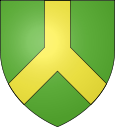Wide fraction
| Wide fraction | ||
|---|---|---|

|
|
|
| region | Grand Est | |
| Department | Bas-Rhin | |
| Arrondissement | Haguenau-Wissembourg | |
| Canton | Brumath | |
| Community association | Basse anger | |
| Coordinates | 48 ° 45 ' N , 7 ° 47' E | |
| height | 143-187 m | |
| surface | 15.11 km 2 | |
| Residents | 2,832 (January 1, 2017) | |
| Population density | 187 inhabitants / km 2 | |
| Post Code | 67500 | |
| INSEE code | 67523 | |
| Website | http://www.weitbruch.fr/ | |

Weitbruch is a French commune with 2832 inhabitants (as of January 1, 2017) in the canton of Brumath in the Bas-Rhin department in the Grand Est region (until 2015 Alsace ). She is a member of the Communauté de communes de la Basse Zorn .
geography
The community is located in the Upper Rhine Plain, 24 kilometers north of Strasbourg and 13 kilometers south of Haguenau . Surrounding communities are Haguenau in the north, Brumath in the south and Niederschaeffolsheim in the west.
Of the 1,511 hectares in the municipality, around 600 are forested, 750 are used for agriculture and 160 are settled. 670 hectares are privately owned.
history
middle Ages
Around the year 743 the place was called Uiccobrocho or Wiccobrocho . Later place names were Wibbruch (1166), Wipruch (1266), Witbruch (1337), Vitbruch (1434), and Wibruech . The village got its current name when the Alemanni gained the upper hand in Alsace. Weitbruch was bought in 1332 by the Lords of Lichtenberg from the successors of the Landgraves in Alsace and assigned to the Brumath office. It was an imperial loan . From 1166 local lower nobility is attested.
Anna von Lichtenberg (* 1442; † 1474), one of Ludwig V's two heirs, married Count Philip I the Elder of Hanau-Babenhausen (* 1417; † 1480) in 1458, who had a small secondary school from the County of Hanau had received in order to be able to marry her. The county of Hanau-Lichtenberg came into being through the marriage . After the death of the last Lichtenberger, Count Jakob, one of Anna's uncle, Philip I d. Ä. In 1480 half of the Lichtenberg rule, the other half went to his brother-in-law, Simon IV. Wecker von Zweibrücken-Bitsch . The Brumath office was initially a condominium between Hanau-Lichtenberg and Zweibrücken-Bitsch. Under the government of Count Philip III. From Hanau-Lichtenberg there was then a real division: The Brumath office came entirely to Zweibrücken-Bitsch. In contrast, the Willstätt office , which also came from the Lichtenberg legacy and was a condominium between the two houses, was transferred entirely to the County of Hanau-Lichtenberg.
Modern times
However, there was another inheritance in 1570, which also brought the Brumath office and thus the village of Weitbruch to the County of Hanau-Lichtenberg: Count Jakob von Zweibrücken-Bitsch (* 1510; † 1570) and his brother Simon V. Wecker , who had died in 1540, left behind only one daughter each as heiress. Count Jakob's daughter, Margarethe (* 1540; † 1569), was married to Philipp V von Hanau-Lichtenberg (* 1541; † 1599). The legacy resulting from this constellation also included the second half of the former Lichtenberg lordship, which was not already ruled by Hanau-Lichtenberg, and included the Brumath office with wide break. In 1570, the ruling Count of Hanau-Lichtenberg also carried out the Reformation in Weitbruch , in the Lutheran version.
Due to France's reunification policy , the Amt Brumath and the village of Weitbruch also fell under French suzerainty in 1680.
1736 died with Count Johann Reinhard III. the last male representative of the Hanau family. Due to the marriage of his only daughter, Charlotte (* 1700; † 1726), with the Hereditary Prince Ludwig (VIII.) (* 1691; † 1768) of Hesse-Darmstadt , he inherited the county of Hanau-Lichtenberg. In the course of the French Revolution , the left bank of the Hanau-Lichtenberg county - and thus also Weitbruch - fell to France.
Population development
| 1798 | 1962 | 1968 | 1975 | 1982 | 1990 | 1999 | 2006 | 2017 |
|---|---|---|---|---|---|---|---|---|
| 711 | 1725 | 1909 | 2083 | 2264 | 2323 | 2473 | 2662 | 2832 |
literature
- Jean-Claude Brumm: Quelques dates importantes dan l'histoire… . In: Société d'Histoire et d'Archaeologie de Saverne et Environs (ed.): Cinquième centenaire de la création du Comté de Hanau-Lichtenberg 1480–1980 = Pays d'Alsace 111/112 (2, 3/1980), p 10f.
- Fritz Eyer: The territory of the Lords of Lichtenberg 1202-1480. Investigations into the property, the rule and the politics of domestic power of a noble family from the Upper Rhine . In: Writings of the Erwin von Steinbach Foundation . 2nd edition, unchanged in the text, by an introduction extended reprint of the Strasbourg edition, Rhenus-Verlag, 1938. Volume 10 . Pfaehler, Bad Neustadt an der Saale 1985, ISBN 3-922923-31-3 (268 pages).
- Friedrich Knöpp: Territorial holdings of the County of Hanau-Lichtenberg in Hesse-Darmstadt . [typewritten] Darmstadt 1962. [Available in the Hessisches Staatsarchiv Darmstadt , signature: N 282/6].
- Alfred Matt: Bailliages, prévôté et fiefs ayant fait partie de la Seigneurie de Lichtenberg, du Comté de Hanau-Lichtenberg, du Landgraviat de Hesse-Darmstadt . In: Société d'Histoire et d'Archaeologie de Saverne et Environs (eds.): Cinquième centenaire de la création du Comté de Hanau-Lichtenberg 1480–1980 = Pays d'Alsace 111/112 (2, 3/1980), p 7-9.



